Tree lily: an overview of varieties, planting, care and reproduction
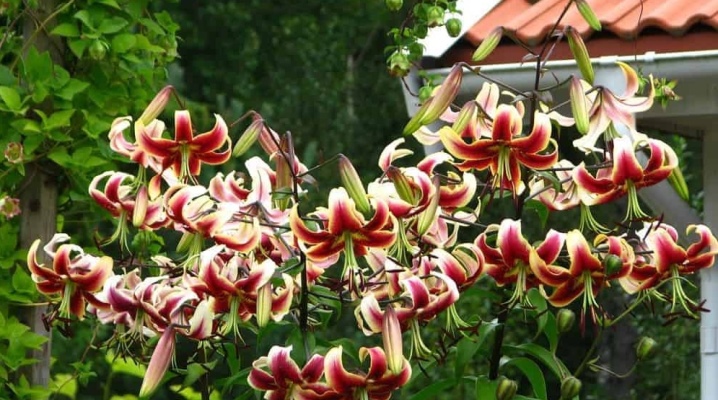
Several years ago, unusual plants appeared on sale: two-meter lilies with giant flowers of various colors (from dark blue to bright yellow). Sellers with "honest" eyes, showing bright, poor quality photos made in Photoshop, assure surprised buyers that this is a tree lily. And deceived people shell out large sums for ordinary lily bulbs.
In the spring, of course, common lilies bloom among would-be flower growers, as a rule, the cheapest ones with pink flowers. For the stated claims, sellers accuse the buyers themselves of improper care of the plantings and, of course, immediately find new victims for deception.


What is a lily tree?
So what exactly is a "tree lily" and does it exist in nature at all - we will help readers to understand this issue.
Lily is a bulbous perennial belonging to the Liliaceae family. There are many types and varieties of this plant with a variety of flower colors. There are dwarf lilies, with a stem length of no more than 15 cm, and giant lilies, growing up to 2.5 meters. These tall species are called tree lilies, although, of course, they have nothing to do with trees.

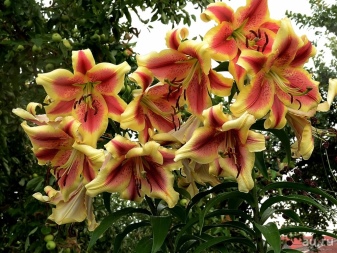
Types and popular varieties
There are two types of lily trees.
Species lilies
These are tree-like lilies that can be found in the wild, but it is almost impossible to grow them on your site, and sometimes even dangerous. In our climate, natives of other countries do not grow, such as "Candidum", "Speziosum", "Auratum", "Nepalense". Our tiger lily grows very well, but by planting it, you can lose your beautiful garden plants, as it is a carrier of the mosaic virus.
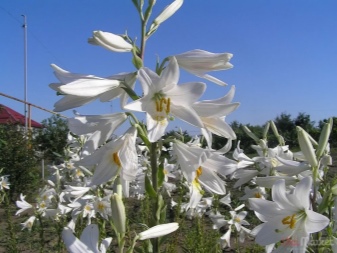
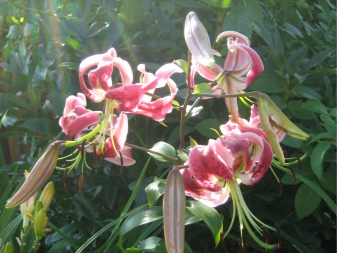

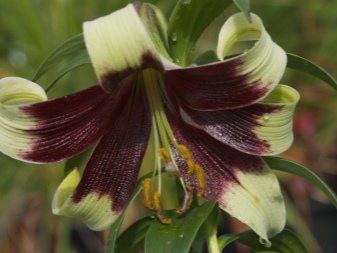
It is worth describing the cardiocrinum lily in more detail, as it is now gaining more and more popularity. Cardiocrinum "Gigantum" - an alien from Asia... It has heart-shaped leaves. The cardiocrinum blooms in the 4-5th year, after which the bulb dies off, but daughter bulbs form around it.
The plant is quite whimsical, therefore, like all species of lily trees, it is difficult to grow it.
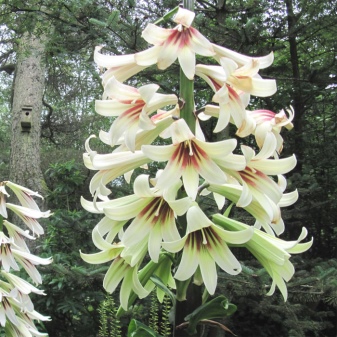
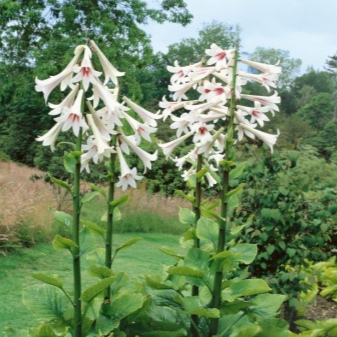
Oriental-Tubular Hybrids
These lilies are obtained by a complex hybrid crossing of Oriental and Trumpets hybrids. Hence they got their name: OT hybrids.
This type of lily has tall, strong stems with a lot of flowers. Plants hardy, resistant to various diseases.
Therefore, they are grown everywhere - both for cutting and for decorating garden plots.
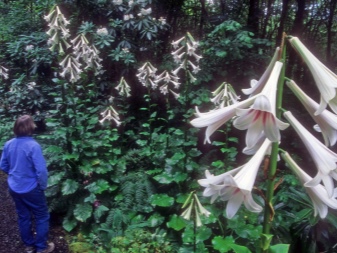

Let us consider in more detail the description of some varieties of OT-hybrid lilies.
- "Purple Prince". Truly a prince among lilies, growing up to two meters in height. Its giant flowers are up to 30 cm in diameter. Silk petals of a rich dark burgundy color with a yellow center in the bud look generally black. The Purple Prince was bred in Canada and refined in Holland. The variety is resistant to diseases, temperature extremes.
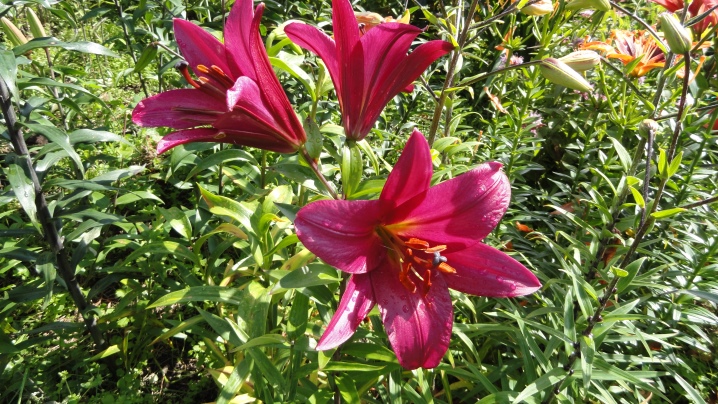
- "Pretty woman" (translated means "beauty"). The stems reach 2.5 meters in height, while they are so strong that they do not even require a garter. Large fragrant flowers, when opened, are creamy, and then turn white. "Pretty woman" is unpretentious, will grow well and bloom in any area.

- Scheherazade. A tree lily that grows up to 2.5 meters under good conditions. The flowers are large, bowl-shaped, directed downward. The petals are bright pink with a yellow border and golden center, covered with numerous specks. "Scheherazade" refers to late varieties of lilies, blooms in late August.

- "Anastasia". Late flowering variety of giant lily. Flowers 25-30 cm in diameter with bright pink in the center and light along the edge of the petals with a white throat. Delivers a delicate pleasant aroma in the morning and evening. The stem reaches 1.5-2 meters. Lily is undemanding to the conditions of detention.

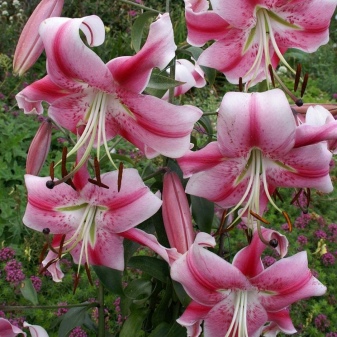
Landing rules and care features
All OT-hybrid lily-trees are unpretentious and easy to care for. But if you want to see the tree lily in all its glory, then you need to take into account some features when growing these plants.
- When purchasing a tree lily bulb, it is necessary to carefully study the requirements for the growing conditions of this variety, since they may differ for different lilies.
- OT hybrids do not develop very well on calcareous soil; neutral or slightly acidic soils are preferable for them.
- Do not plant lilies in places where water stagnates (in spring when snow melts or during rains).
- Lilies-trees love sunny places, but for much longer they will delight with their flowering in partial shade.
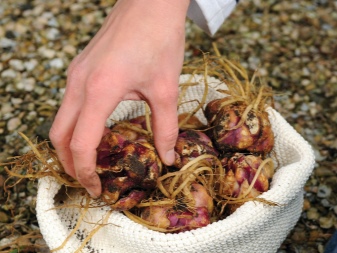
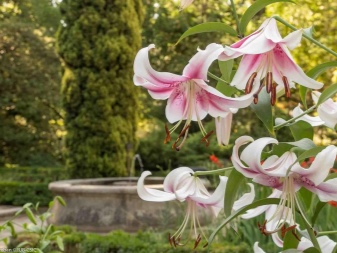
After purchasing the planting material, it is advisable to plant the bulbs immediately in a permanent place. If not already cooked, the bulbs can be stored in a cool, dark place. You can plant lilies in open ground in the second half of spring or early autumn.
The planting process is as follows.
- Remove dry scales from the bulbs.
- Dig holes, the depth of which should be equal to three times the height of the bulbs. The distance between the holes should be between 5 and 15 cm (depending on the size of the bulbs).
- Pour drainage at the bottom of the holes. In this case, it is coarse sand.
- Plant a lily bulb in each hole, cover with soil, into which you can add a little humus.
- Water, mulch the plantings with sawdust, dry leaves or wood chips.



Further care consists in timely watering, weeding, fertilization and removal of wilted flowers.
Reproduction
Giant lilies can grow without transplanting for 5-7 years. When the bulb ages, the flowers become smaller, the stems grow short. That's why, in order to preserve the plant variety you like, it must be propagated. There are many ways to accomplish this task.
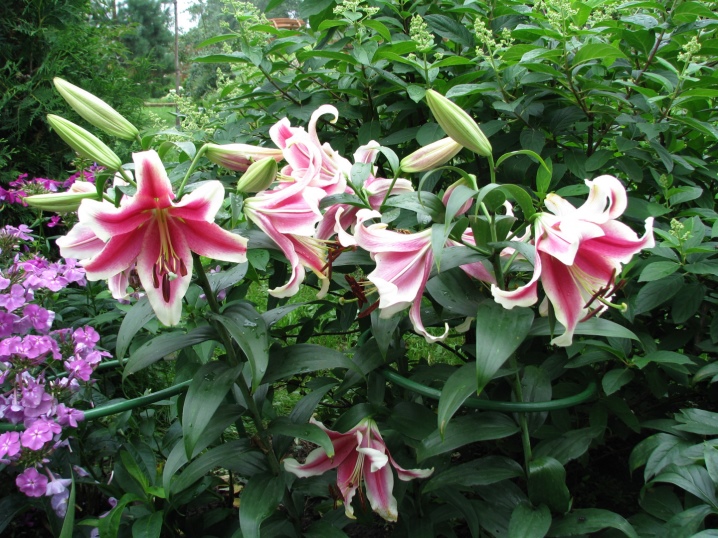
Daughter bulbs
This is the easiest breeding method that every lily lover probably used. After flowering, it is necessary to dig out the bush, separate the bulbs from the mother plant and immediately plant them in the prepared place. Young plants will bloom in the second year after planting. If the daughter bulbs are too small, then it is better to plant them in a separate place for growing, so that they are not lost in the flower garden.


By dividing the nest
This method is similar to the previous one. If instead of one stem, several grow from the rhizome of the lily, then you need to dig up the plant, divide the nest into separate adult bulbs and plant them in a permanent place. By doing this in the fall, next summer you will already have flowering plant specimens.


Scales
This breeding option is not difficult, but the flowering of plants will have to wait up to 5 years. It concludes in the separation of scales from the mother bulb (no more than 5 pieces) and planting them in moist peat in containers. The scales should be immersed in the ground no more than half. Then you need to make a greenhouse, a simple plastic bag is suitable for this. After about a month, or maybe even earlier, small bulbs with roots are formed on the scales, up to 5 pieces on each scale.
When they grow up, they can be planted in the growing area.I must say that tree lilies are not very willing to form children, therefore, when reproducing in this way, you need to be patient.

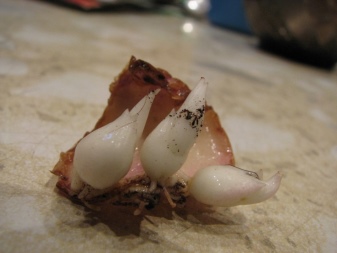
Stem cuttings
This method is used when breeding especially valuable varieties of lilies, which practically do not give daughter bulbs and do not form nests. In the spring, when the buds have not yet formed, it is necessary to cut the stem of the lily and divide it into cuttings 8-10 centimeters long. Then, at an angle, plant in the ground with the addition of peat and sand, shade from the sun. After 5-7 weeks, bulbs will appear in the sinuses. When they grow up a little, they can be planted for growing in special containers or on a separate bed in open ground.
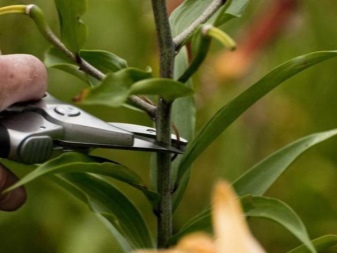
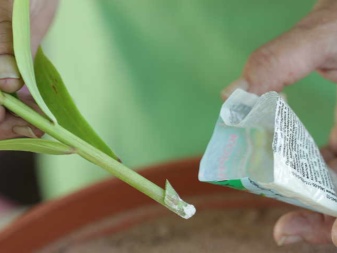
Seeds
This method is good only for those who like to experiment. Plants grown from seeds do not retain varietal characteristics, so you definitely won't grow a lily tree. Seeds should be sown in light soil at the end of winter. Freshly picked ones sprout well. Plant young plants for growing in a separate bed. OT hybrids will bloom 8-10 years after sowing.

Diseases and pests
Treelike, like all other types of lilies, are affected by numerous diseases and pests.
- Gray rot - a fungal disease, one of the most dangerous. Brown spots appear on the stem and leaves of plants from below, which then grow and turn into a gray slimy plaque. This fungus grows during sudden changes in temperature, as well as in damp weather. Diseased specimens lose their decorative effect, stop growing and blooming. They must be treated with a fungicide every 2 weeks.
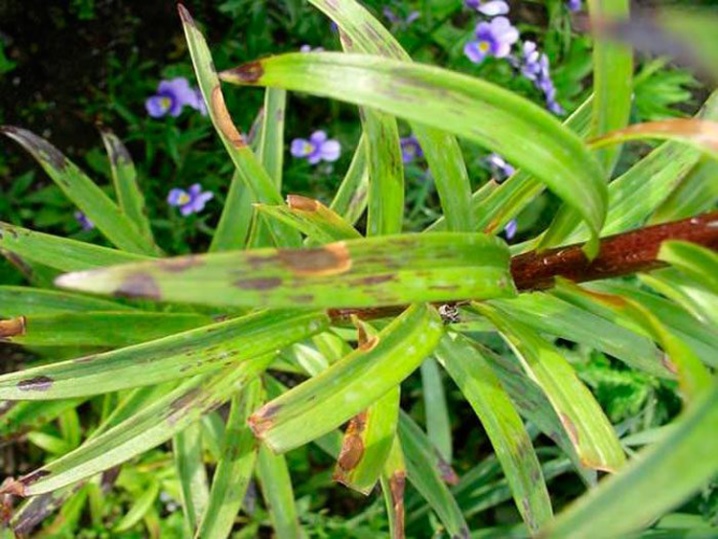
- Fusarium - in an outwardly healthy plant, the bottom of the bulb rots due to increased soil moisture. Lily cannot endure the winter and dies. One can only guess about the disease, since the lily looks completely healthy. To prevent fusarium, you need to shed the bed with a solution of copper sulfate 2 weeks before planting the bulbs. If the summer is rainy, then the plants can be treated with a foundationol solution every 2 weeks.
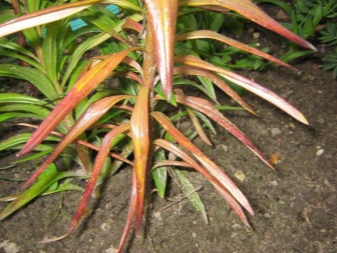

- Cercosporosis - a very common disease. Whitish, colorless, yellow or brown spots appear on the tips of the leaves. Then they grow to the center of the leaves. This happens in a rainy summer, when the plantings are thickened. For prophylaxis in the spring, plants can be sprayed with phytosporin. And if the disease has already appeared, the bushes should be treated with a solution of Bordeaux liquid, fungicides.

- Anthracnose - a fungal disease in which brown shapeless spots with “burnt-out” edges appear on the leaves, stems and bulbs. Anthracnose can be easily cured in the initial stage, when only the leaves are affected, by treating the lily bushes with a fungicide. Before treatment, it is imperative to remove the damaged parts of the plants.
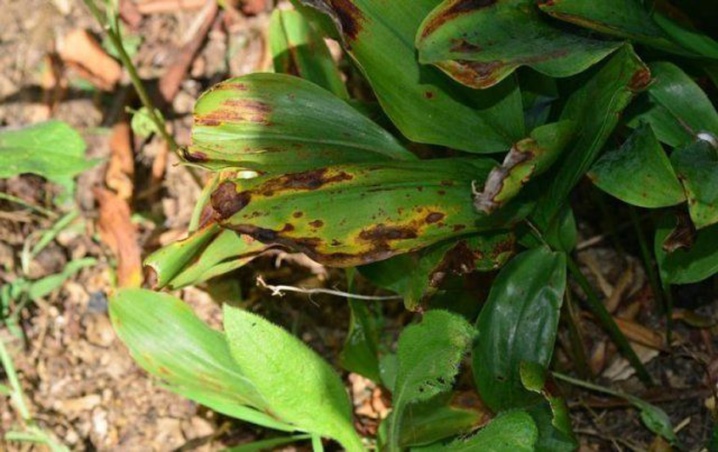
- Rhizoctonia - a disease that affects lily bulbs. Mold forms between the scales, the stems sprout curved, the plant dies. The fungus that causes rhizoctonia lives in soil for up to 10 years. Attempts can be made to treat diseased plants with fungicides. If this fails, you need to dig out the diseased lilies and destroy them, and replace the soil in the beds.
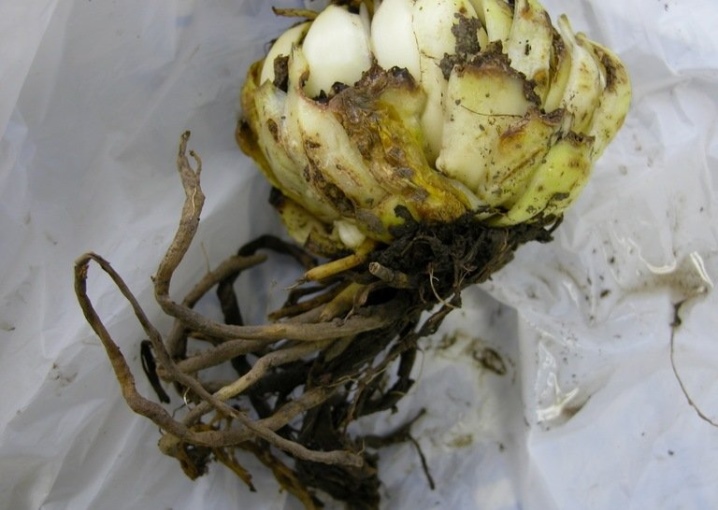
- Phithium - affects the roots of lilies, as a result of which the plant cannot receive nutrients from the soil, weakens, dries, and loses its decorative appearance. The tips of the leaves turn yellow. You can save the lilies. It is necessary to dig them up, remove rotten and dried out areas, soak the bulbs in a solution of foundation. Re-plant in a fresh substrate, disinfected with a solution of colloidal sulfur.
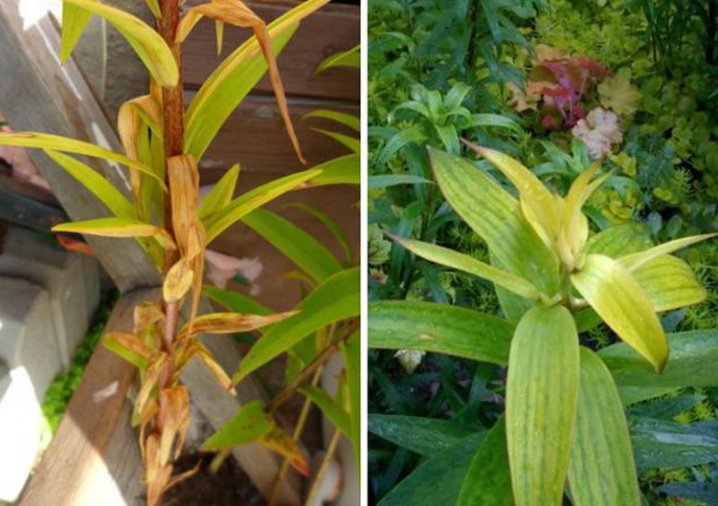
- Blue mold - during storage of the bulbs, greenish mold forms. Then the bulbs turn yellow, the roots die off, the lilies die. To prevent blue mold from infecting plants, all storage rules must be observed: temperature, humidity, ventilation, disinfection.
Diseased bulbs must be destroyed.
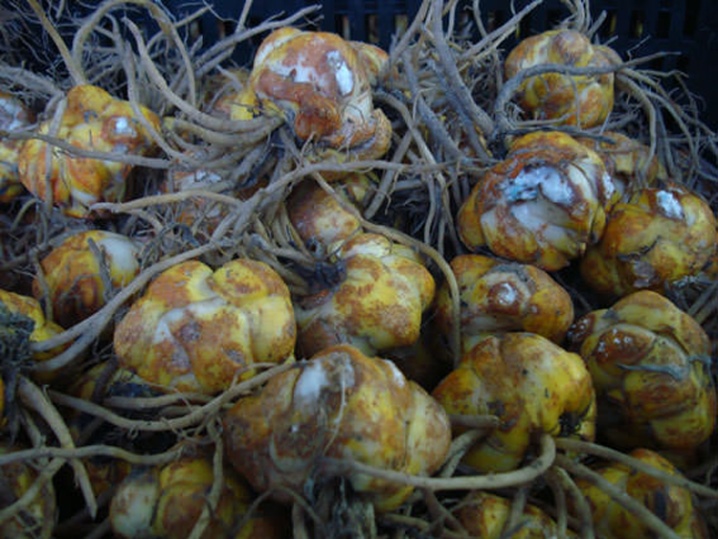
- Rust - its appearance is due to the presence of a fungus. First colorless and then ocher "rusty" spots appear on lilies. Plants die. The infected parts of the flower must be destroyed. Sprinkle the lilies with the Tsineba solution.
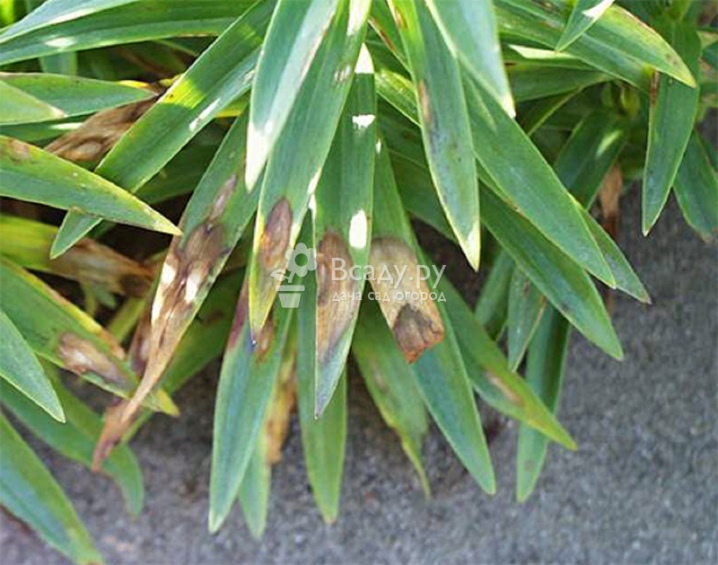
- Cucumber Mosaic Virus - carried by aphids. Light spots appear on leaves and flowers. The plant is deformed. To prevent infection of all plants, you need to carefully inspect the plantings, destroy spotted leaves or even whole plants. Treat aphids in time.
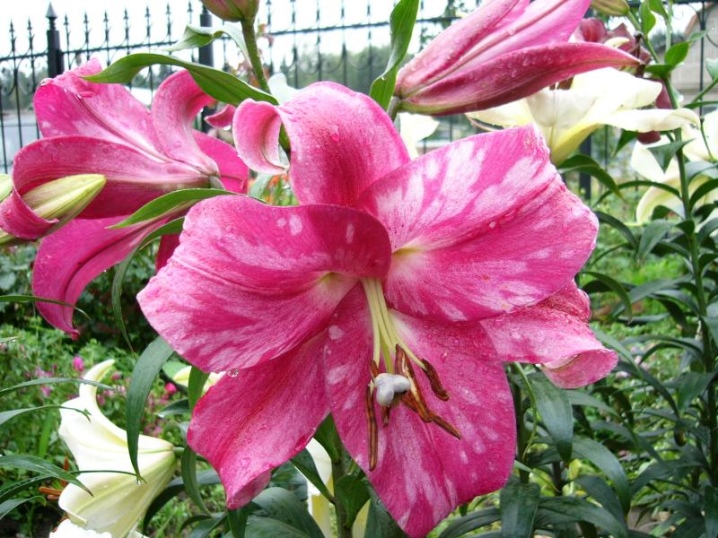
- Variegated Virus - an intracellular virus... Spots and strokes appear on the petals of lilies. Lilies grow smaller, weaken, varieties degenerate. Plant protection consists in timely treatment against aphids, the destruction of already infected flowers.

In addition to diseases, plants can be attacked by insect pests.
- Spider mite - arachnid, sucking the sap of plants and braiding the lower part of the leaves with the finest cobweb. Lily leaves are deformed, plantings die. Treatment with acaricides will help against spider mites.
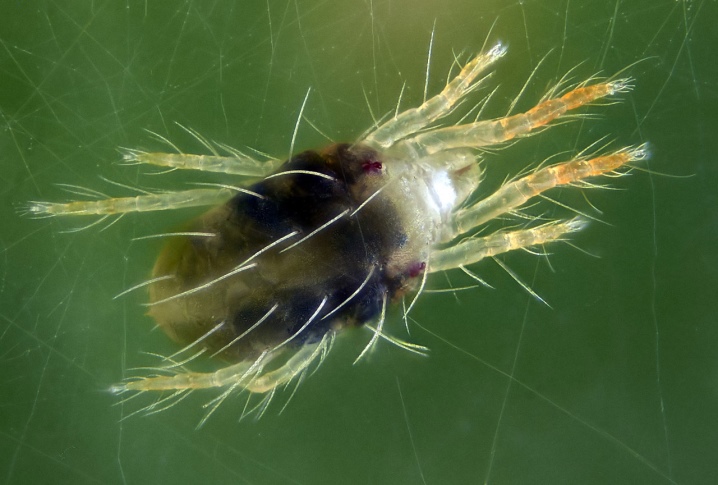
- Squeak beetle - the bright red larvae of this beetle are dangerous. They completely eat up the lily leaves. For destruction, you need to spray the planting with insecticides.

- Lily fly - fly larvae live in lily buds, eating stamens and pistils of flowers. To combat this pest, you need to remove the buds where the lily flies have started, then treat with an insecticide.
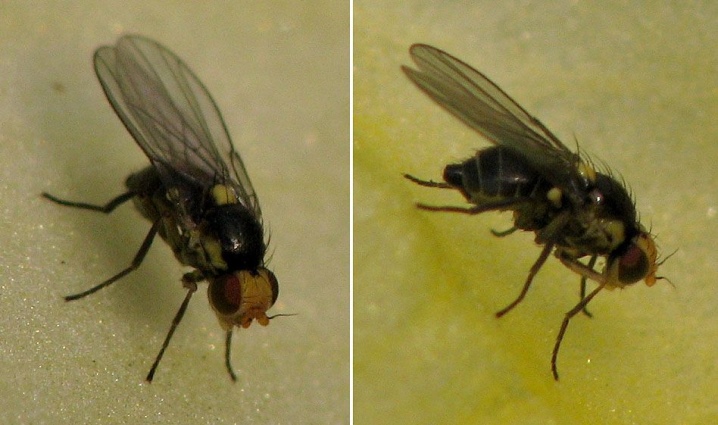
- Medvedka - affects the underground parts of the plant, most often the stem. The lily quickly fades and dies. To destroy the bear on the site, traps are made from rotted manure in the soil. Chemicals such as "Medvetox", "Grizzly" are applied under the plants.
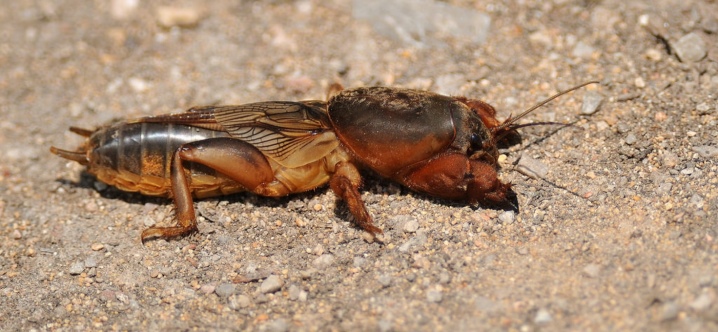
- Onion fly - lays the larvae on the surface of the earth. Then they crawl into the lily bulbs, which causes decay. Control measures: spraying with insecticide and pre-planting treatment of bulbs with "Bazudin".
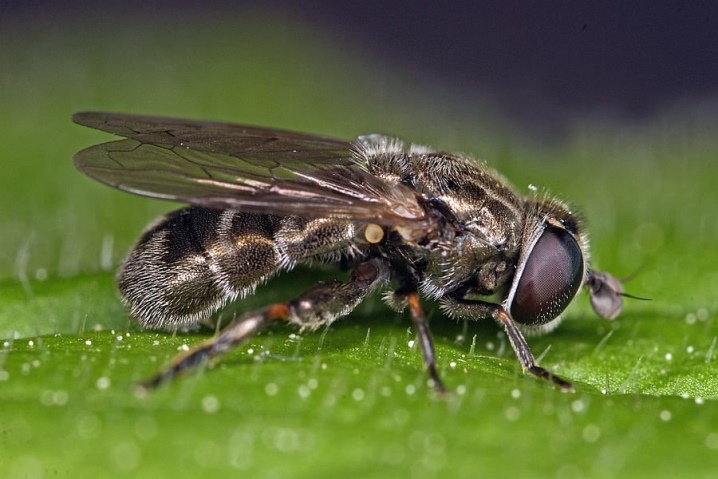
- Wireworm Is the larva of the click beetle. Gnaws passages in the bulbs, after which the plants become weakened, wither and dry out. The wireworm can be harvested by hand by digging up a patch of OT hybrids. If there are a lot of plantings, treat with a fungicide, according to the instructions.
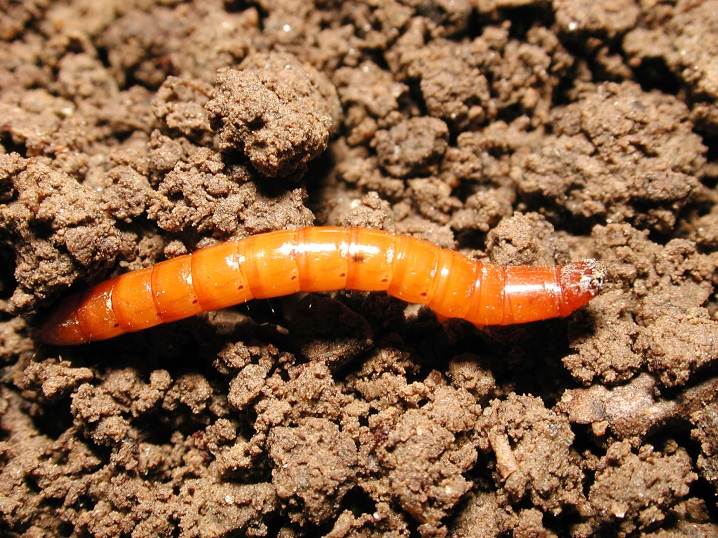
Examples in landscape design
Due to the wide range of colors of tree lilies, as well as different flower shapes, they are commonly used to decorate garden plots.
- Giant OT hybrids can be used to restrict the site by planting along the fence.


- You can plant a group of lilies as a tapeworm on your lawn.


- The beauty of the flowers of giant lilies is emphasized by bushes planted in the background or short trees with a dense crown.


- Fragrant varieties will delight with their fragrance around gazebos, verandas, terraces.


- Varieties of tree lilies can be selected so that their flowering succeeds each other from early spring to late autumn.


All about the tree lily, see the video below.







































































































The comment was sent successfully.